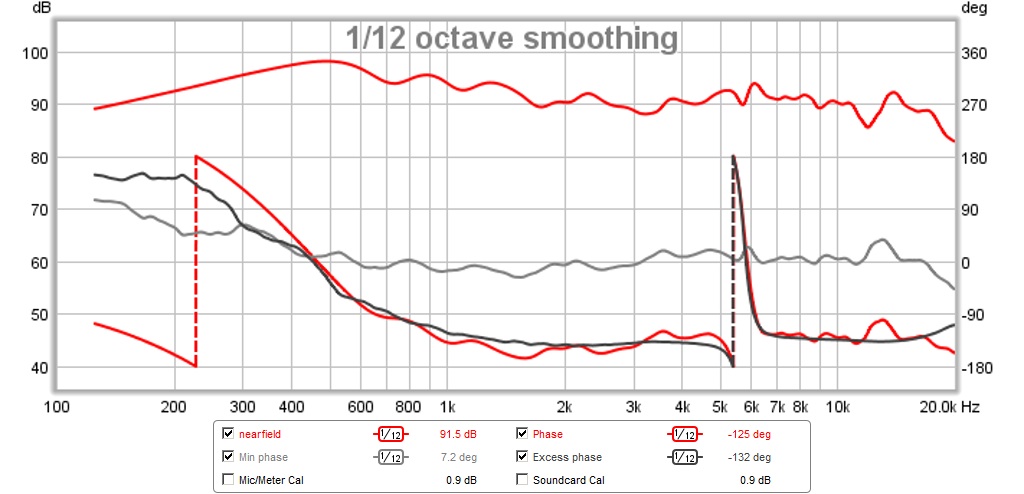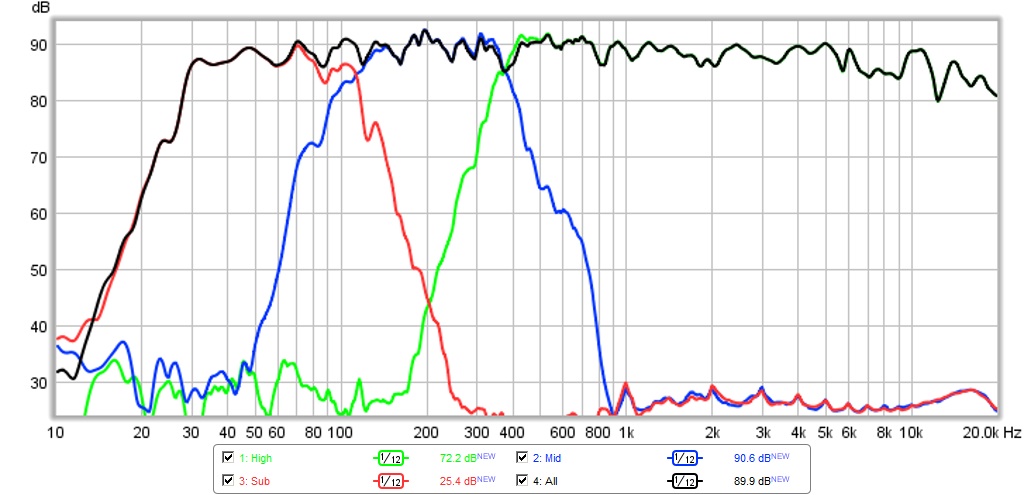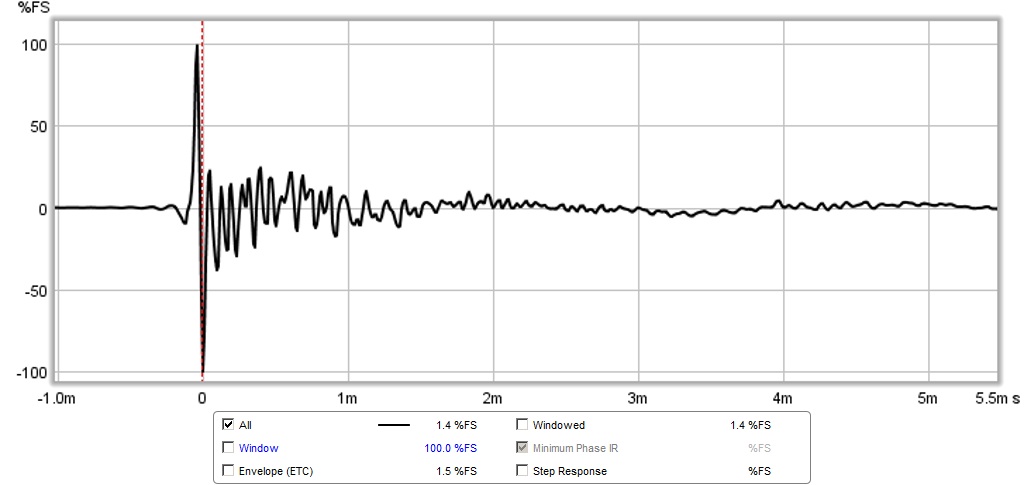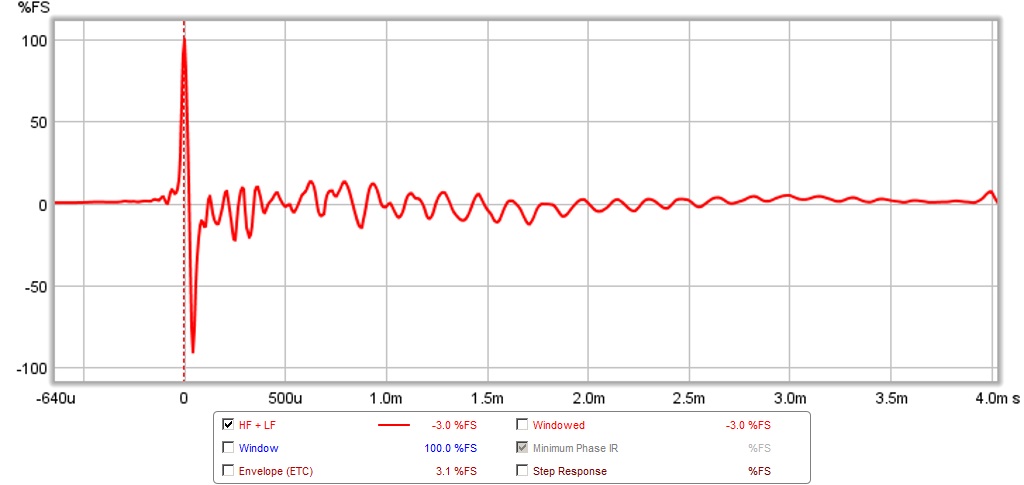Can someone please explain what measurements you are talking about.
I have an audio oscillator, a good amplifier and a calibrated dB meter.
I've got a couple of Flukes and a 'scope if that is of any help.
I have an audio oscillator, a good amplifier and a calibrated dB meter.
I've got a couple of Flukes and a 'scope if that is of any help.
the likelihood of a company that has been in the speaker business a long time marketing a very expensive kit that sounds like rubbish compared to something being wrong.
I think that likelyhood is quite high based on other posts in this forum. You seem unable to accept that WA are trading on a name when there are stories out there of the main designer leaving some years ago and setting up on his own leaving them possibly bereft of speaker design skills.
I am not sure continuing this is wise but I am making no comment on the quality of the kit beyond it not sounding like rubbish. I know nothing about the personnel changes at Wilmslow and if you say the main designer has left then he may well have done for all I know. The only point I am making is that if one builds a kit and it sounds wrong then there is every chance a mistake has been made and not to immediately assume it is rubbish.You seem unable to accept that WA are trading on a name when there are stories out there of the main designer leaving some years ago and setting up on his own leaving them possibly bereft of speaker design skills.
Can someone please explain what measurements you are talking about.
I have an audio oscillator, a good amplifier and a calibrated dB meter.
I've got a couple of Flukes and a 'scope if that is of any help.
You need a basic calibrated measurement mic like a UMIK or Dayton UMM-6 ($70). Download REW software (free).
Make a measurement of frequency response. The software uses FFT to get you impulse. You get harmonic distortion, phase, etc. All sorts of good stuff. Really critical to have if you are designing/building/DIY speakers.
. The only point I am making is that if one builds a kit and it sounds wrong then there is every chance a mistake has been made and not to immediately assume it is rubbish.
And my point it to NOT assume that the builder has not taken due care in the build. If you read the full thread he has put a lot of time and care in. You cannot seem to accept that it might just be a generic 3-way crossover they had that in fact doesn't work well with these drive units.
I think its even odds over something simple (a phase reversal needed somewhere) or a company having 2 models with different tweeter and midrange units but a substantially identical crossover.
FWIW the designer of the prestige (ATC midrange) left wilmslow at least 10 years ago SPEAKER KITS and seems to have since vanished off the internet.
You need a basic calibrated measurement mic like a UMIK or Dayton UMM-6 ($70). Download REW software (free).
Make a measurement of frequency response. The software uses FFT to get you impulse. You get harmonic distortion, phase, etc. All sorts of good stuff. Really critical to have if you are designing/building/DIY speakers.
More info please.
More info please.
REW software here:
REW - Room EQ Wizard Room Acoustics Software
UMM-6 here (sometimes on sale for $70):
Dayton Audio UMM-6 USB Measurement Microphone*
If you want to use your own sound card and know how to calibrate it, you can use this:
Amazon.com: Dayton Audio EMM-6 Electret Measurement Microphone: Musical Instruments
You can also do it the cheap, uncalibrated way and that can work quite well if you don't need absolute SPL. Use Panasonic mic capsule $2 and follow instructions here: John Conover: Using the Panasonic WM61A as a Measurement Microphone
and here on SL's site: System Test
Holmimpulse software can also be used and is good but REW lets you see many more traces at once and is easier to use (IMO).
HOLM Acoustics
Here are examples of what REW and a $70 mic can do for you:
Phase and response:

XO design:

Impulse response (you can see how clean a transient is - in this case sibilance is very apparent):

Here is an example of a cleaner impulse response:

These are all examples from the Trynergy thread: http://www.diyaudio.com/forums/full-range/261427-presenting-trynergy-full-range-tractrix-synergy.html
Last edited:
I am not sure continuing this is wise but I am making no comment on the quality of the kit beyond it not sounding like rubbish. I know nothing about the personnel changes at Wilmslow and if you say the main designer has left then he may well have done for all I know. The only point I am making is that if one builds a kit and it sounds wrong then there is every chance a mistake has been made and not to immediately assume it is rubbish.
May I add a personal opinion. I have built the Prestige kit before WA differentiated it in 3 models. My speakers have volt/atc /scan 9900 ( this is now called "Gold" I think) I have also upgraded the crossovers with premium parts and moved them outside the cabinet without changing anything in the schematics. These are extremely good speakers , certainly equal if not better then commercial designs costing these days up to 15000 euros. They sit aside my Quads 2905 ( amplifiers are Spectral 15 pre and studio 160 power or alternatively QuickSilver V4). They are more dynamic than the Quads and show the same level of trasparency ,although the Quads, for classical music, seems to my ears to get closer to the tonal timbre of the "original sound"( I have been a happy owner of quad 63 for almost 30years..) but I really cannot say which is "best". People at WA are also very kind and in my experience competent enough.
Ciao,
Bruno
I think its even odds over something simple (a phase reversal needed somewhere) or a company having 2 models with different tweeter and midrange units but a substantially identical crossover.
As I said a long time ago, from the base transfer functions I'd expect to see both the mid and trebble inverted to the bass, doesn't matter how this is achieved.
May I add a personal opinion. I have built the Prestige kit before WA differentiated it in 3 models. My speakers have volt/atc /scan 9900 ( this is now called "Gold" I think) I have also upgraded the crossovers with premium parts and moved them outside the cabinet without changing anything in the schematics.
This is good to know, but I think we're all in agrement that the schematic just doesn't look right at all, it would tie in to them loosing a lead designer, if that's the case.
At any rate I don't think it's necessary to spend this thread debating the merits or failings of WA, instead we need to get feedback from the OP about how they sound as a stereo pair, and if reversing the driver phase helps.
After that we can move on to getting somewhere.
Though just to be safe, maybe the OP can post a photo of the crossover?
This is my last post on this topic. I said a mistake had been made I did not say the OP had made the mistake.And my point it to NOT assume that the builder has not taken due care in the build. If you read the full thread he has put a lot of time and care in. You cannot seem to accept that it might just be a generic 3-way crossover they had that in fact doesn't work well with these drive units.
You can take a reasonable frequency response measurement with this kit in an anechoic chamber but not a living room because of reflections. However if you measure at the same close distance from each drive unit in turn you may see enough to work out what is wrong. By measuring close to a drive unit the sound from that drive unit will be the loudest and contribute most to the reading. However sound doesn't radiate from the drive units in the same way and so what is flat at the listening position is not going to be flat close to the drive units. Nonetheless a plot of all three frequency responses on the same piece of paper may reveal problems.KatieandDad said:I have an audio oscillator, a good amplifier and a calibrated dB meter.
I've got a couple of Flukes and a 'scope if that is of any help.
I've no idea even what the complaint is about these speakers, but can suggest that the correct polarity should be ++- bass, mid to tweeter.
boxsim-db.de | Boxsim Projektdatenbank
If you read back a two pages to my previous post, you get a similar result with the Celestion Ditton 66.
In general the best way to get an answer is to state the problem clearly, assemble all the pieces that lead to a solution, then think it over.
boxsim-db.de | Boxsim Projektdatenbank
If you read back a two pages to my previous post, you get a similar result with the Celestion Ditton 66.
In general the best way to get an answer is to state the problem clearly, assemble all the pieces that lead to a solution, then think it over.
I've no idea even what the complaint is about these speakers, but can suggest that the correct polarity should be ++- bass, mid to tweeter.
so we have one person convinced it should be -++ you saying ++- and a crossover diagram for the ATC version which is +++
IF if is an inversion, then it should be possible with only a sig gen and SPL meter to spot the nulls without needing to lug the speaker into the garden. will be interesting to see if that is the case.
so we have one person convinced it should be -++ you saying ++- and a crossover diagram for the ATC version which is +++
IF if is an inversion, then it should be possible with only a sig gen and SPL meter to spot the nulls without needing to lug the speaker into the garden. will be interesting to see if that is the case.
If there's a null you can normally hear it long before the meter comes out!
But yes, polarity should be checked, I'm guessing it's been crossed at 500 and 4000 he, so measure there for a start
I could run the Wilmslow circuit through a simulator again, if I was sure what exact circuit to look at. Or why I should care. 😀
Midrange (and treble) cones and domes have entirely different low frequency behaviour, so look out for that.
This little Windows freebie called SweepGen does a nice job of signal generating:
Audio Tools - from David Taylor, Edinburgh
Midrange (and treble) cones and domes have entirely different low frequency behaviour, so look out for that.
This little Windows freebie called SweepGen does a nice job of signal generating:
Audio Tools - from David Taylor, Edinburgh
Attachments
Last edited:
so we have one person convinced it should be -++ you saying ++-
and a crossover diagram for the ATC version which is +++
I got the impression both of the persons were suggesting the same thing.
FWIW, they both could or not be wrong. I have similar configuration
back home and all 3 drivers are in phase and it is the right thing to do
in my case.
HaHa, design a 3 way in ten minutes? Why not? 😱
I just had a go at that wilmslow circuit. What we need to know here is that a midrange dome is quite well time aligned with a dome tweeter. So the usual 2nd order mid with third order tweeter isn't strictly needed.
So it all worked very nicely with second order tweeter on LR2 slopes and ++-. When I made the tweeter third order, phase went to pieces by about 90 degrees and I suppose it was nearer BW3 slopes. And it worked on either polarity. Which is what BW3 does. One polarity sounds better than the other IMO. The one with that keeps the phase more aligned at 1kHz, which is ++- here, but it may be debateable.
So I'm just a bit confused, unusual though it is at diyaudio to admit to being anything less than all-knowing and wise. 😀
I just had a go at that wilmslow circuit. What we need to know here is that a midrange dome is quite well time aligned with a dome tweeter. So the usual 2nd order mid with third order tweeter isn't strictly needed.
So it all worked very nicely with second order tweeter on LR2 slopes and ++-. When I made the tweeter third order, phase went to pieces by about 90 degrees and I suppose it was nearer BW3 slopes. And it worked on either polarity. Which is what BW3 does. One polarity sounds better than the other IMO. The one with that keeps the phase more aligned at 1kHz, which is ++- here, but it may be debateable.
So I'm just a bit confused, unusual though it is at diyaudio to admit to being anything less than all-knowing and wise. 😀
Last edited:
System 7,
How was your impedance on the sim?
Mine was all over the place... about 10 for the bass and dropping to 5 for the mid and treble... not nice.
I struggled to integrate that tweeter, but 2nd order worked as well as 4th on the mid/treble for me too... admittedly I was working my way through a bottle of rum last night though , so yeah... I just found b it a really odd combination of drivers.
what did you do about impedance/from plots for your sim?
I was using pcd 7 and traced lines from manufacturers data
How was your impedance on the sim?
Mine was all over the place... about 10 for the bass and dropping to 5 for the mid and treble... not nice.
I struggled to integrate that tweeter, but 2nd order worked as well as 4th on the mid/treble for me too... admittedly I was working my way through a bottle of rum last night though , so yeah... I just found b it a really odd combination of drivers.
what did you do about impedance/from plots for your sim?
I was using pcd 7 and traced lines from manufacturers data
The thing is a passive high pass at 400Hz and a 16Ohm driver requires about 12µF and 12mH while same but with an 8ohm driver needs 24µF and 6mH.
So either the components can be identical or the xover frequency and slope but not both.
I just used an online L-R2 calculator to get a rough idea. In fact it appears to me (and I could well be wrong) using the 16Ohm component values with an 8 Ohm driver results in a -6dB/oct slope from 1600Hz down while the inductor kicks in below 100Hz instead of straight -12dB/oct from 400Hz.
The above from a year ago I am not sure was fully resolved. But if someone with a sim plugs in the x-over values from page 22 with the data for the volt midrange it might be interesting to find out what the midrange response would look like.
I am intrigued to find out what is amiss here.
You are probabaly far more accurate than me. I don't even know much about the drivers, except it's a 12" woofer with a very efficient dome mid and scanspeak tweeter. I assumed 8 ohms nominal throughout, though I know the SS is about 4 ohms.System 7,
How was your impedance on the sim?
Mine was all over the place... about 10 for the bass and dropping to 5 for the mid and treble... not nice.
I struggled to integrate that tweeter, but 2nd order worked as well as 4th on the mid/treble for me too... admittedly I was working my way through a bottle of rum last night though , so yeah... I just found b it a really odd combination of drivers.
what did you do about impedance/from plots for your sim?
I was using pcd 7 and traced lines from manufacturers data
I was just winging it with the usual LR2 acoustic slopes. Very typical that a three way drops to around 4 ohms in the mid and treble. I started with this one: boxsim-db.de | Boxsim Projektdatenbank
What else can you do in 10 minutes? 😀
REW software here:
REW - Room EQ Wizard Room Acoustics Software
UMM-6 here (sometimes on sale for $70):
Dayton Audio UMM-6 USB Measurement Microphone*
If you want to use your own sound card and know how to calibrate it, you can use this:
Amazon.com: Dayton Audio EMM-6 Electret Measurement Microphone: Musical Instruments
You can also do it the cheap, uncalibrated way and that can work quite well if you don't need absolute SPL. Use Panasonic mic capsule $2 and follow instructions here: John Conover: Using the Panasonic WM61A as a Measurement Microphone
and here on SL's site: System Test
Holmimpulse software can also be used and is good but REW lets you see many more traces at once and is easier to use (IMO).
HOLM Acoustics
Here are examples of what REW and a $70 mic can do for you:
Phase and response:

XO design:

Impulse response (you can see how clean a transient is - in this case sibilance is very apparent):

Here is an example of a cleaner impulse response:

These are all examples from the Trynergy thread: http://www.diyaudio.com/forums/full-range/261427-presenting-trynergy-full-range-tractrix-synergy.html
I've ordered the calibrated mic that you suggested. I've got a SoundBlaster Audigy Pro soundcard so that should be OK.
I'm confused are we using the soundcard for both source and for measuring ?
- Status
- Not open for further replies.
- Home
- Loudspeakers
- Multi-Way
- Wilmslow Audio - Prestige platinum
